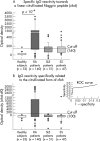Evaluation of anti-citrullinated filaggrin antibodies as hallmarks for the diagnosis of rheumatic diseases
- PMID: 15020336
- PMCID: PMC1754960
- DOI: 10.1136/ard.2003.008623
Evaluation of anti-citrullinated filaggrin antibodies as hallmarks for the diagnosis of rheumatic diseases
Abstract
Background: Anti-filaggrin antibodies (AFA) are among the most specific antibodies for rheumatoid arthritis, so procedures for their detection should be included in early biological diagnoses. AFA can be detected by indirect immunofluorescence (anti-keratin antibodies, AKA) or by new enzyme immunoassays (EIA). Their comparative performance needs to be established.
Objective: To compare these technical procedures to optimise the serological diagnosis of rheumatoid arthritis.
Methods: Results obtained using AKA and EIA were compared in 271 sera from 140 patients with rheumatoid arthritis at various stages, 98 patients with other autoimmune diseases, and 33 healthy subjects. EIA were successively undertaken with citrullinated linear filaggrin peptide (home made EIA) or cyclic citrullinated peptide (CCP2, commercial kits). Rheumatoid factor (RF) was assessed by EIA in all patients.
Results: Anti-CCP2 kits showed the best sensitivity and specificity (65% and 96%, respectively). Among the 140 patients with rheumatoid arthritis, those with very recent disease (less than six months' duration, n = 21) were studied as a separate group. In this group, the sensitivity of anti-CCP2 kits decreased to approximately 50%. Nevertheless this assay remained the most accurate when compared with AKA or home made EIA using linear filaggrin peptides. The combination of anti-CCP2 and RF only slightly increased the sensitivity of the diagnosis of very early rheumatoid arthritis.
Conclusions: Kits using citrullinated cyclic peptides (CCP2) were more suitable than either AKA or EIA using linear filaggrin peptides for the diagnosis of early rheumatoid disease.
Figures

References
Publication types
MeSH terms
Substances
LinkOut - more resources
Full Text Sources
Medical

